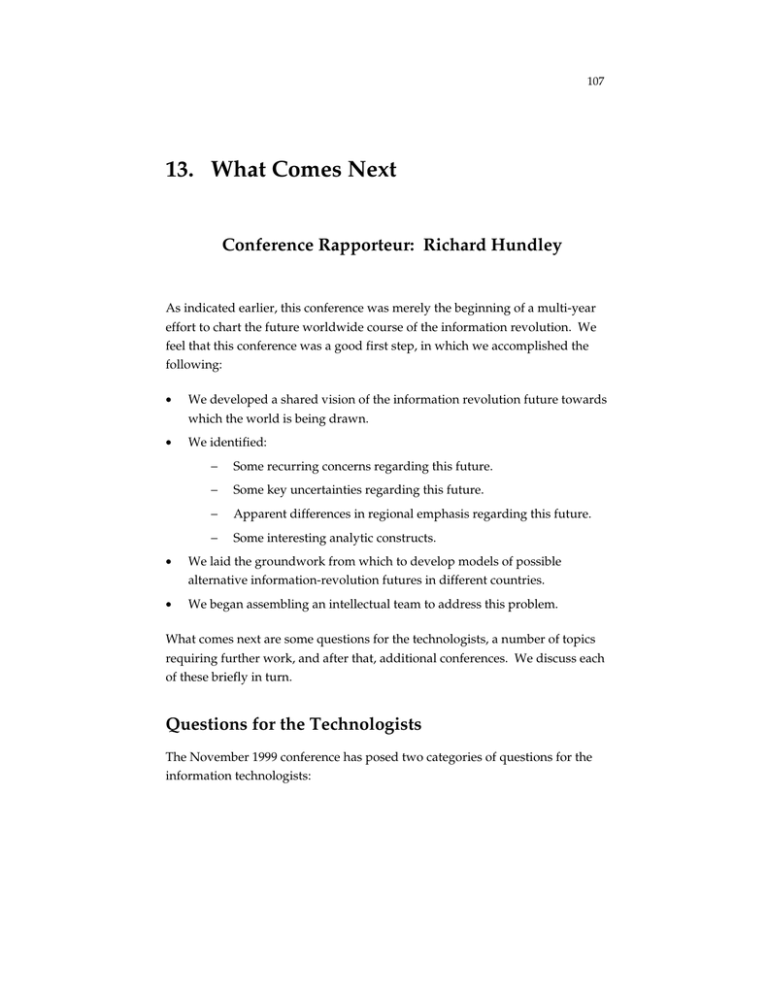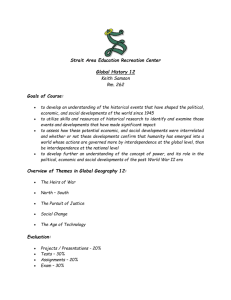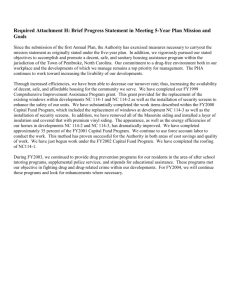13. What Comes Next Conference Rapporteur: Richard Hundley
advertisement

107 13. What Comes Next Conference Rapporteur: Richard Hundley As indicated earlier, this conference was merely the beginning of a multi-year effort to chart the future worldwide course of the information revolution. We feel that this conference was a good first step, in which we accomplished the following: • We developed a shared vision of the information revolution future towards which the world is being drawn. • We identified: − Some recurring concerns regarding this future. − Some key uncertainties regarding this future. − Apparent differences in regional emphasis regarding this future. − Some interesting analytic constructs. • We laid the groundwork from which to develop models of possible alternative information-revolution futures in different countries. • We began assembling an intellectual team to address this problem. What comes next are some questions for the technologists, a number of topics requiring further work, and after that, additional conferences. We discuss each of these briefly in turn. Questions for the Technologists The November 1999 conference has posed two categories of questions for the information technologists: 108 A. How may technology, artifact, and roles/usage developments50 over the next 10-20 years add to the characteristics of “the great IR attractor”? Such developments could include: • Technology, artifact, and roles/usage developments leading to new business paradigms -- beyond the current e-commerce paradigm. • Technology, artifact, and roles/usage developments leading to new paradigms in education, 51 medicine and health care, entertainment, or other societal areas. • Technology, artifact, and roles/usage developments that increasingly couple cyberspace to physical space. • Technology, artifact, and roles/usage developments leading to new computing paradigms (e.g., quantum computing, DNA-based computing, etc.) -- during the next 20 years. 52 B. How may technology developments over the next 10-20 years facilitate the access of have-nots to the information revolution, or otherwise cause differential impacts in various regions of the world? Such developments could include: • Developments that avoid (or overcome) requirements for education (e.g., the current keyboard-style interface) and/or cultural change in order to effectively access information technology. • Developments that reduce the amount of infrastructure (e.g., electric power grid, telecommunications network, etc.) required to effectively access information technology. • Developments that remove (or overcome) language barriers. • Developments that could enable some nations or regions in the developing world to skip stages that the developed world has gone through in the past (e.g., skipping land-lines and going right to a wireless-based telecommunications network). These questions will be addressed during a Spring 2000 conference. ______________ 50 We are using the terminology “technology, artifact, and roles/usage” here in the sense described in Section 10. 51 Particularly entertainment viewed as a venue through which social, political, and cultural values are transferred from one nation or society to another. 52 The 1997 ACM conference (see Denning and Metcalfe, 1997, and Denning, 1999) identified a number of new computing paradigms that could come to fruition over the next 50 years. The time horizon for our current effort is only 20 years. So the question is: which of these new computing paradigms are likely to come to fruition during this shorter time period? 109 Topics Requiring More Work The November 1999 conference identified a number of topics requiring further work. These include: • Models of the information revolution. We need to flesh out the set of models presented in Section 12 in much more detail, and begin “assigning” nations to each of the various models. • The information revolution in Latin America. We need a small workshop focused on this subject, to broaden and deepen our understanding of the course of the information revolution in this part of the world. • The future course of IT penetration. Papers presented at the November conference presented a quantitative picture of the state of IT penetration throughout the world today, focusing primarily on the Internet. We need to expand this picture beyond the Internet, to other aspects of IT technology, and develop quantitative projections of future IT penetration throughout the world, insofar as possible. • “Proximity” in the information age. We need to better understand which societal activities will cluster geographically, and which will disperse. These topics will be worked on during the coming months. And After That: Additional Conferences Once the above items are (substantially) complete, we anticipate holding two more major international conferences, preferably in Europe and in Asia, to expose and vet our results before a wider international audience, thereby broadening and deepening our models of the future course of the information revolution throughout the world.





